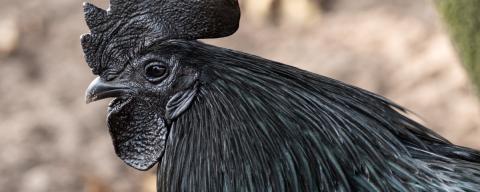Raising backyard chickens in New Hampshire is a great way to be more self-sufficient and is both fun and educational for kids of all ages. There are many breeds to choose from and most have been bred for their ability to produce a lot of eggs or to gain weight quickly to be used as meat birds. However, if you’re looking for a fun way to diversify your flock, consider adding one or more of these interesting and rare breeds to your coop!
Ayam Cemani Chickens
First on the list is truly a stunner. The Ayam Cemani is a breed of chicken that is totally black and not just on the outside. Its feathers, skin and even its internal organs and bones are all jet black in color! These birds have a friendly temperament but can be described as alert or slightly nervous, which is a holdover trait from their wild ancestors. In Indonesia, they were thought to have mystical properties and were often raised for royalty. This is a very rare breed that may be hard to find, but if you are lucky enough to find them for sale, they are sure to turn some heads!

The Ayam Cemani is a breed of chicken whose feathers, skin and even its internal organs and bones are all jet black in color.
Silkie Chickens
Next on the list is the very fun, very fluffy Silkie breed. Originating from China, Japan or India (depending on who you ask), this breed has feathers that resemble fur and cover almost their entire bodies. Like the Ayam Cemani, their skin is usually dark blue to black in color. These birds are considered an ornamental breed because they tend to produce few eggs. They may just steal your heart with their adorable fuzzy appearance and their small stature!
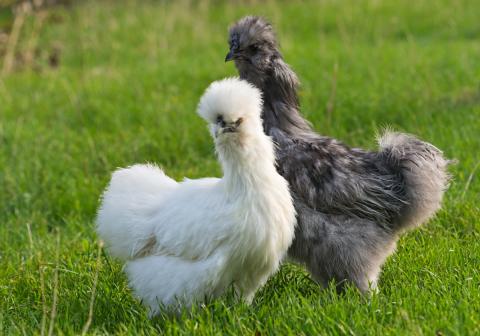
Silkies have feathers that resemble fur and cover almost their entire bodies.
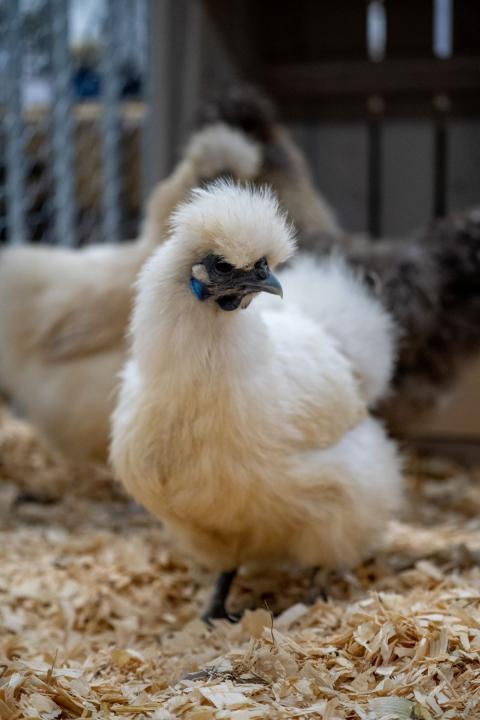
Silkie chickens have fluffy feathers.
Yokohama Chickens
This fancy, long-tailed breed is another showstopper to add to your coop. Originally hailing from Japan and further developed in Germany in the 1800s, the long tail feathers and bright white color of this breed will add a lot of interest to your flock. They, like Silkies, are relatively poor egg layers (only 80-100 per year) and because of that they are considered an ornamental breed. Happiest when they have a lot of space, these birds will do best in a free-range situation.
Bantam Chickens
The term “bantam” simply refers to the hundreds of miniature breeds of chickens that have been developed over the years. Some of these have full-sized counterparts with the same name — a result of crossbreeding full-sized and miniature breeds, and others are their own unique breeds that only come in one small size. Their diminutive stature and generally friendly demeanor make them a fun breed to raise, especially with kids. Since they take up less space than regular breeds, they are also great for small yards or urban spaces. Keep in mind that small breed chickens may require insulated and/or heated coops to stay warm during the coldest months as they are less cold hardy than most full-size breeds. They also tend to lay smaller eggs than larger birds.
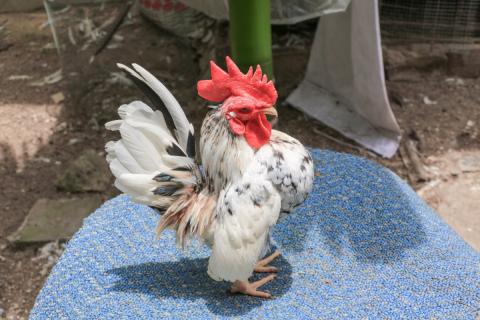
The term “bantam” simply refers to the hundreds of miniature breeds of chickens that have been developed over the years.
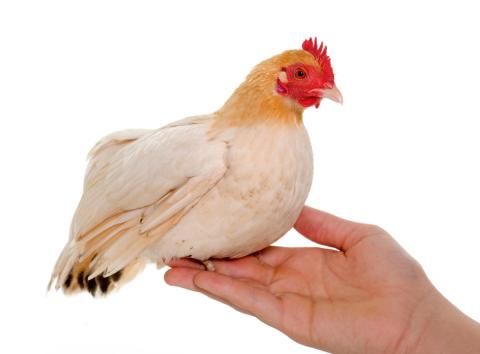
The diminutive stature and generally friendly demeanor of bantam chickens make them a fun breed to raise.
Modern Game Chickens
Have you ever seen a chicken that stands almost two feet tall? Modern Game chickens were originally bred for cockfighting, but when this practice fell out of favor they found a home with breeders' clubs in the UK who appreciated this chicken’s uncommonly tall characteristics. These birds are lean and lightweight despite their tall growth habit. They make great pets but can be somewhat aggressive toward children. Like bantams, this breed may need an insulated or heated coop because they don’t have a dense layer of down feathers like many more common breeds. Also, don’t forget to make sure your coop is tall enough to support their unusual height!
There are many, many more unique breeds of chickens out there beyond this list. Be sure to do plenty of research to make sure any of these unique chicken breeds are right for you and your situation. One note about mixing different sized chickens or chickens with far different temperaments: Keep in mind that larger and more aggressive chickens may pick on smaller or more docile breeds. You may need to keep some birds separated or you may decide to keep a more homogenous flock to avoid issues. For more information about rare and threatened livestock species, check out The Livestock Conservancy.
Do you love learning about stuff like this?
SUBSCRIBE TO Granite State Gardening newsletter
Got questions? The Ask UNH Extension Infoline offers practical help finding answers for your home, yard, and garden questions.
Call toll free at 1-877-398-4769, Monday to Friday, 9 a.m. to 2 p.m., or e-mail us at answers@unh.edu.
